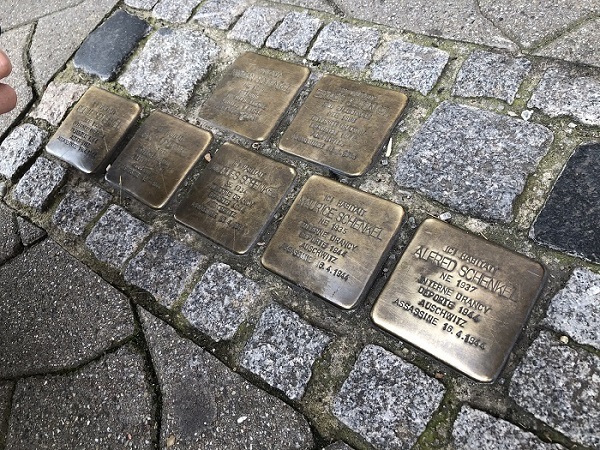Have you noticed the little golden cobblestones on some pavements in Strasbourg that stick slightly out of the ground? They are Stolpersteine. A German artist thought of them to celebrate the memory of victims of Nazism. Strasbourg already has twenty, dotted here and there around the city.
“Here lived Nathan Schenkel, born in 1896, Refugee at La Bachellerie, shot down on 1.4.1944” “Here lived Esther Schenkel, née Zilberman, in 1898, detained at Drancy, deported in 1944 to Auschwitz, assassinated on 16.4.1944” All members of the Schenkel family are there, lined up as seven small squares under the feet of those walking over the cobblestones in rue de Barr in Strasbourg. Esther and Nathan Schenkel were Jews from Poland. They and their five children, Cécile, Isaac, Jacques, Maurice, and Alfred, born between 1930 and 1937, were rounded up in Périgueux. The father was killed on the spot, the mother and children were deported then exterminated in April 1944 at the Auschwitz camp.

Aim: 850
Although the way cobblestones are lined up catches the attention of curious passers-by, few know what they are yet, such as one of the residents of the building where the Schenkel family lived before the war. These cobblestones are called Stolpersteine in German, and are part of the twenty that were laid in Strasbourg on 1 May 2019.
The German artist Gunter Demnig had the idea for the Stolperstein concept, which literally means “stone that you trip up on”, consisting of recalling the fate of the victims of Nazism by making those walking down the street “trip up” on the brass-covered concrete cobblestones engraved by hand.
The project in Strasbourg was supported by the Stolpersteine 67 association, following negotiations with the Bas-Rhin Jewish Consistory, the City and Eurométropole. The aim is that within the next few years, Strasbourg has Stolpersteine for each of the 850 Jews of the city that were deported and killed by the Nazi regime, as pointed out by Fabienne Regard, president of the Stolpersteine 67 association, when they were being laid.
Recap of a fate
Christophe Woerhlé was behind the first Stolpersteine laid in Alsace, at Mutterholtz on 30 April 2019 and Herrlisheim-près-Colmar (68). This Alsace historian carried out research to trace victims. Each cobblestone sums up in 9.6 cm² how a victim of Nazism died, always tragically: “died” or “assassinated”, “fate unknown” for unclear cases, “escaped in death’ for those who committed suicide. Those making the request must research the victims’ fate for each of them.
Researching death certificates took Christophe Woerhlé six to eight months, from the Archives of victims of contemporary conflicts, in Caen, to those of Yad Vashem (World Holocaust Remembrance Centre) in Jerusalem. The historian looked for the tracks of deportation, by checking the reference, convoy number, the presence on deportation lists.

“The files were kept better at the Buchenwald camp”
“The date of date was never indicated at Auschwitz. We set it as being within the five days after arrival in camp. The files in Buchenwald were kept better, with arrival dates”. Once the death certificate was established, Christophe Woerhlé referred to the National Office for Veterans and Victims of War to obtain the indication “Died for France”.
But unlike Germany or other countries where the cobblestones were placed in front of where the victims’ last lived freely, in Alsace they were placed where the victims had lived or in front of the house they were born in. “As no Jew was deported directly from Alsace: they were evicted in France in 1940, where they were rounded up later”.
More than 75,000 around the world
History teacher in Germany. Christophe Woerhlé had two Stolpersteine laid in Bamberg in memory of two French war prisoners, then two others in south-west France, in 2013, for victims of Forced Labour. Others were for political prisoners in Vendée, Charente Maritime and Gironde. “Before that, an initial request for Stolpersteine in France for Jewish victims was refused for the reason that France is a secular country”, grimaced the historian.
To date, more than 75,000 cobblestones have already been laid on in 26 European countries and Argentina.
“They replace a grave”

Through these cobblestones, the artist Gunter Demnig “does not want to make people trip up over the stones themselves, but rather their hearts and minds”. He is as inspired as he is tireless, having laid memorial cobblestones since 1997, when he started doing so spontaneously in memory of Jews victim of Nazism, as part of an artistic exhibition on the memory of Auschwitz. Since then he has never lacked energy travelling around to cities, on the contrary.
“The most important is the reaction of people when they see these cobblestones and the emotion the families feel for whom, sometimes, they replace a grave. That’s what the true artistic approach is, more than the cobblestones themselves. What is very important too is how interested young people are: it’s different reading in a book that millions of Jews were exterminated and finding out, thanks to these cobblestones, what happened in a very specific place”, explains Gunter Demnig.
“You should bow”
The artist quotes the Talmud to explain his approach: “A person is only forgotten when their name is forgotten”. This is where his wish to unite “a cobblestone, a name, a human
being” comes from. And in choosing brass to cover it, the artist accepts that the more we walk on the cobblestones, the more the brass is polished and the message can be read. Which broadened the memorial gesture out to all victims of Nazism: not only Jews but also the disabled, deserters, political activists, victims due to their sexual orientation or skin colour, forced labourers...
“If you want to read the names of the victims and know what happened to them, you should bow a little to them in addition… I see this to be one of the essential aspects.
Lucie Michel